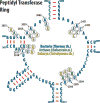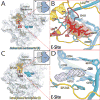Elements of ribosomal drug resistance and specificity
- PMID: 22981944
- PMCID: PMC5560274
- DOI: 10.1016/j.sbi.2012.07.016
Elements of ribosomal drug resistance and specificity
Abstract
The structures of ribosomes in complex with inhibitors of translation have not only shed light on the interactions of antibiotics with the ribosome but also on the underlying mechanisms by which they interfere with the ribosome function. Several recent papers [1(•),2(••),3,4] have correlated the available ribosome structures with the wealth of biochemical data [5(•)]. In this review we shall focus on the lessons learned for drug specificity rather than presenting a comprehensive survey of the known structures of ribosome complexes with antibiotics.
Copyright © 2012 Elsevier Ltd. All rights reserved.
Figures





Similar articles
-
Antimicrobial agents targeting the ribosome: the issue of selectivity and toxicity - lessons to be learned.Cell Mol Life Sci. 2007 Apr;64(7-8):791-5. doi: 10.1007/s00018-007-6431-5. Cell Mol Life Sci. 2007. PMID: 17429579 Free PMC article. Review. No abstract available.
-
Macrolide antibiotics in the ribosome exit tunnel: species-specific binding and action.Ann N Y Acad Sci. 2011 Dec;1241:33-47. doi: 10.1111/j.1749-6632.2011.06315.x. Ann N Y Acad Sci. 2011. PMID: 22191525 Review.
-
The bacterial ribosome as a target for antibiotics.Nat Rev Microbiol. 2005 Nov;3(11):870-81. doi: 10.1038/nrmicro1265. Nat Rev Microbiol. 2005. PMID: 16261170 Review.
-
Ribosome-targeting antibiotics and mechanisms of bacterial resistance.Nat Rev Microbiol. 2014 Jan;12(1):35-48. doi: 10.1038/nrmicro3155. Nat Rev Microbiol. 2014. PMID: 24336183 Review.
-
Basis for prokaryotic specificity of action of aminoglycoside antibiotics.EMBO J. 1999 Jun 1;18(11):3133-8. doi: 10.1093/emboj/18.11.3133. EMBO J. 1999. PMID: 10357824 Free PMC article.
Cited by
-
Structures of proline-rich peptides bound to the ribosome reveal a common mechanism of protein synthesis inhibition.Nucleic Acids Res. 2016 Mar 18;44(5):2439-50. doi: 10.1093/nar/gkw018. Epub 2016 Jan 24. Nucleic Acids Res. 2016. PMID: 26809677 Free PMC article.
-
Deletion of L4 domains reveals insights into the importance of ribosomal protein extensions in eukaryotic ribosome assembly.RNA. 2014 Nov;20(11):1725-31. doi: 10.1261/rna.046649.114. Epub 2014 Sep 22. RNA. 2014. PMID: 25246649 Free PMC article.
-
Phenotypic Suppression of Streptomycin Resistance by Mutations in Multiple Components of the Translation Apparatus.J Bacteriol. 2015 Sep;197(18):2981-8. doi: 10.1128/JB.00219-15. Epub 2015 Jul 6. J Bacteriol. 2015. PMID: 26148717 Free PMC article.
-
Structural basis for the inhibition of the eukaryotic ribosome.Nature. 2014 Sep 25;513(7519):517-22. doi: 10.1038/nature13737. Epub 2014 Sep 10. Nature. 2014. PMID: 25209664
-
Insights into the molecular mechanism of translation inhibition by the ribosome-targeting antibiotic thermorubin.Nucleic Acids Res. 2023 Jan 11;51(1):449-462. doi: 10.1093/nar/gkac1189. Nucleic Acids Res. 2023. PMID: 36546783 Free PMC article.
References
-
- Wilson DN. The A–Z of bacterial translation inhibitors. Critical Reviews in Biochemistry and Molecular Biology. 2009;44:393–433. An extensive review of the recent structures of inhibitors bound to the ribosome. - PubMed
-
- Sohmen D, Harms JM, Schlunzen F, Wilson DN. Enhanced SnapShot: Antibiotic inhibition of protein synthesis II. Cell. 2009;139:212–212 e211. An appealing graphical representation of the effects of many different classes of inhibitors on protein translation. - PubMed
-
- Poehlsgaard J, Douthwaite S. The bacterial ribosome as a target for antibiotics. Nat Rev Microbiol. 2005;3:870–881. - PubMed
-
- Kannan K, Mankin AS. Macrolide antibiotics in the ribosome exit tunnel: species-specific binding and action. Antimicrobial Therapeutics Reviews: Antibiotics That Target the Ribosome. 2011;1241:33–47. - PubMed
-
- Spahn CM, Prescott CD. Throwing a spanner in the works: antibiotics and the translation apparatus. J Mol Med (Berl) 1996;74:423–439. in combination with [1] and [41] represent most of the knowledge accumulated on inhibitors of protein translation over the past decades. - PubMed
Publication types
MeSH terms
Substances
Grants and funding
LinkOut - more resources
Full Text Sources
Medical

